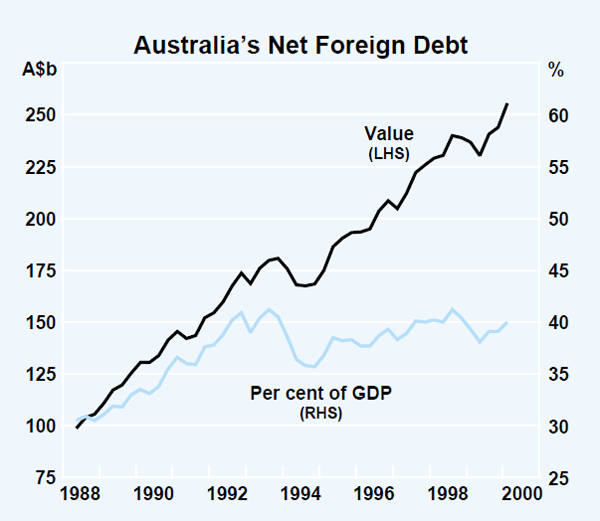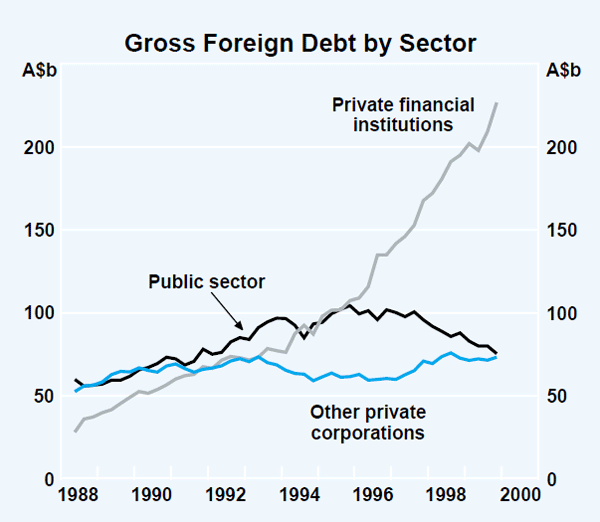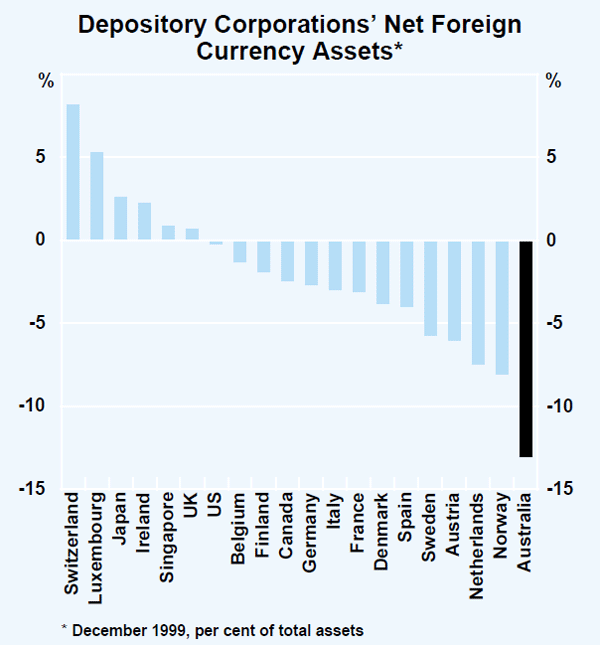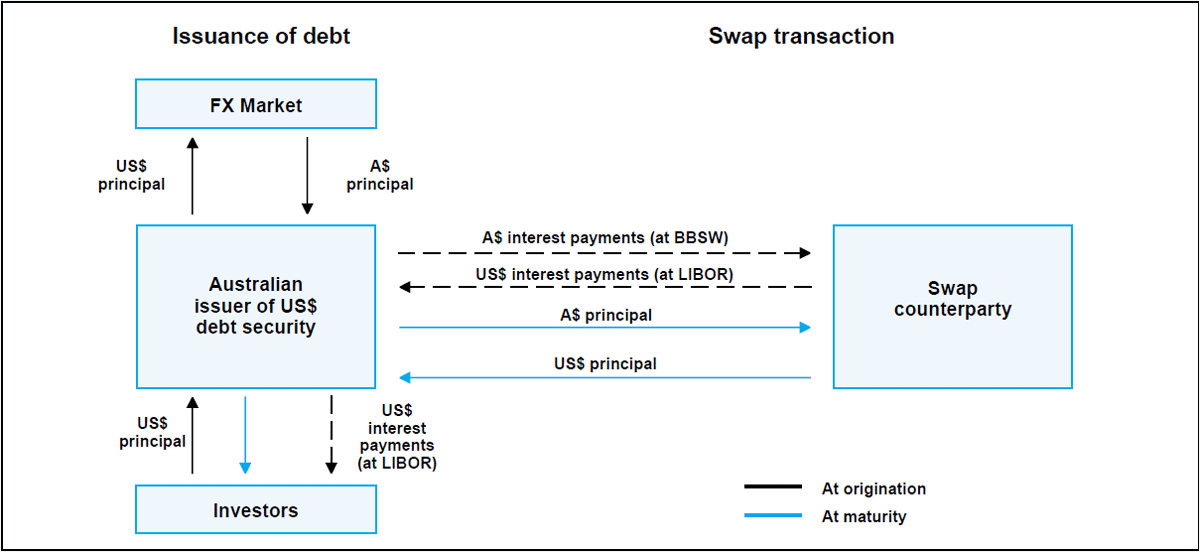Bulletin – August 2000 Foreign Exchange Exposures of Australian Banks
- Download 88KB
Introduction
In the past few years, Australian banks have increased their use of offshore debt markets to diversify their funding. This has not led to an overall increase in banks' foreign currency exposures, however, because the debt is either raised in Australian dollars or hedged back to Australian dollars (through off-balance sheet transactions).
This note outlines banks' foreign debt activities and how they fit into the broader picture of Australia's foreign debt.
The Structure of Australia's Foreign Debt
As a proportion of GDP, Australia's net foreign debt has been broadly steady throughout most of the 1990s, at around 40 per cent (Graph 1). The dollar value of debt has risen from $130 billion to $250 billion over the period. This latter figure represents the net of foreign debt liabilities of around $380 billion and foreign debt assets of around $130 billion.

Within the overall debt statistics, two relatively large sectoral shifts have been occurring:
- the public sector's call on national savings has declined sharply as both Commonwealth and State Governments moved to reduce, and eventually eliminate, budget deficits. From being relatively large issuers of debt in the early 1990s, steady progress in reining in fiscal spending meant that, by 1998, both tiers of government were running budgetary surpluses and were active repurchasers of their debt. In line with the overall reduction in government debt, the amount held by foreigners fell by 25 per cent in the latter half of the 1990s to around $75 billion (Graph 2).

- the rise in the dollar value of foreign debt has been accounted for almost entirely in issuance by financial institutions. Over the 1990s, foreign debt outstanding of the private financial sector grew from $50 billion to around $220 billion.
In contrast, foreign debt issued by private non-financial companies has shown little net change over the period, fluctuating around $70 billion.
This change in the sectoral composition has altered the maturity profile of Australia's foreign debt. Because the financial sector raises most of its funds at shorter maturities than either the government or corporate sectors, as this sector's share of offshore financing has risen, there has been some overall shortening in the maturity of Australia's foreign debt. At the end of 1995, about 30 per cent of foreign debt was in short-term (less than 12 months) instruments; by the end of 1999, this proportion had increased to about 40 per cent. This rise has been due entirely to compositional effects. Within each sector, there was little change in the proportion of short-term debt (Table 1).
| December 1995 | December 1999 | |||
|---|---|---|---|---|
|
Share of total debt (%) |
Proportion in short-term debt instruments (%) |
Share of total debt (%) |
Proportion in short-term debt instruments (%) |
|
| Public sector(a) | 34 | 8 | 19 | 7 |
| Depository corporations | 41 | 55 | 56 | 59 |
| Other | 25 | 21 | 25 | 19 |
| Total | 100 | 31 | 100 | 39 |
|
(a) Excludes public sector depository corporations Source: ABS; RBA calculations |
||||
The question that arises is why an increasing proportion of Australia's foreign debt is being channelled through financial institutions, in particular the banking system. There are two main reasons for this.
The first has to do with the sectoral composition of the demand for credit in Australia. Over the 1990s, debt of households has increased at a much faster pace than business debt. The cumulative increase in the former was around 180 per cent, compared with 45 per cent for the latter. Households cannot approach capital markets (let alone foreign markets) directly to raise debt; they need to go through the banking system. The corporate sector, which could approach capital markets directly, has not had much need for debt and, in any event, has found it increasingly easy to issue debt domestically because of the growth of the corporate debt market.
A related issue is why banks have switched a greater proportion of their funding to offshore rather than simply funding the increased household demand for credit through domestic markets. Part of the answer here is that, given the overall savings/investment balance in Australia (which is reflected in the current account deficit) domestic borrowers would need to offer higher interest rates to meet their financing needs. Against this background offshore funding is comparatively attractive.
Secondly, the continuing impact of financial market deregulation and the development of new financing techniques has supported banks' moves into offshore funding. Deregulation has seen banks become more sophisticated in their funding. They have sought to diversify their funding across different types of instruments, and geographically. They have also sought to reduce costs of funding by using a range of capital and derivative markets to structure transactions, rather than relying on simple domestic instruments. For example, a bank-issued Australian dollar security, has embedded in it a given amount of credit risk, interest rate risk and currency risk, which means the bank needs to find a buyer who wants exactly this combination of risks. A more advantageous approach for the bank might be to use different markets, including offshore markets, to offer each of these risks separately, thereby increasing its potential funding base and lowering its funding costs.
The increased market share of foreign banks following deregulation has also biased funding to offshore, as subsidiaries of foreign banks in particular often find it cheaper to fund themselves through their offshore parents.
Foreign Debt of the Banking Sector
At first glance, the amount of foreign debt issued by the Australian banking sector seems to compare unfavourably with most other developed countries. The Bank for International Settlements (BIS) compiles data on cross-border claims held by and against banks in the industrial countries and other major financial centres. They provide a fairly comprehensive and consistent data set on international banking business.[1] Net foreign currency liabilities represent around 13 per cent of Australian banking assets, higher than any other developed country (Graph 3). Taken by itself, this comparison might suggest that Australian banks are vulnerable to foreign currency risk – the possibility of losses if the local currency falls. This, however, is not the case.

While the Australian banking sector is carrying significant foreign currency exposure on its balance sheet, exposure to foreign exchange movements is negligible as the vast bulk of this exposure is hedged. This can be seen in banks' annual reports, which show that exposures to exchange rate movements are very small. Table 2 shows the daily Value-at-Risk (VaR) from exchange rate changes for the major Australian banks (see Box A for details on VaR). In 1999, the VaR of the major banks amounted to only 0.02 per cent of their banks' capital base. On this measure, Australia's banks run very small exposures to exchange rate changes compared with banks in some other countries.
|
Foreign exchange risk % of capital |
Total market risk % of capital |
|
|---|---|---|
| Australia | 0.02 | 0.08 |
| Canada | 0.02 | 0.12 |
| Netherlands | 0.02 | 0.20 |
| United Kingdom | 0.03 | 0.16 |
| United States | 0.03 | 0.15 |
| Japan | 0.07 | 0.31 |
| Germany | 0.15 | 0.71 |
|
Source: Banks' Annual Reports, 1999 |
||
Box A: Value-at-Risk
Value-at-Risk (VaR) measures the potential loss that an institution would incur in the event of relatively large adverse price movements. Statistical techniques are used to determine the severity of the adverse price movements to be applied. In the calculation, two underlying parameters are specified – the holding period and the desired statistical confidence interval. The holding period refers to the time frame over which changes in portfolio value are measured – is the institution concerned with the potential to lose money over, say, one day, one month or one year? The confidence level defines the proportion of trading losses that are covered by the VaR amount. The figures in Table 2 are based on a one-day holding period and a 99 per cent confidence interval. They are calculated on a global-consolidated basis – that is, they include total exposures arising from each bank's Australian banking operations, offshore activities and non-bank subsidiaries.
More generally, Australian banks do not take on large exposures to changes in other financial market prices either. Last year, the average daily level of total market risk for the four major banks amounted to just 0.08 per cent of their capital base, which is about half that of US banks and one-tenth that of German banks. This measure encompasses exposures to exchange rate movements, as well as banks' exposures to movements in interest rates, and equity and commodity prices.
How can the figures showing large foreign borrowings be reconciled with the fact that banks' exposure to currencies is very small? Part of the answer to this can be seen in foreign investment statistics published by the Australian Bureau of Statistics. These show that, of the $220 billion in foreign debt issued by Australian depository corporations, about $50 billion is used to hold foreign currency assets and another $80 billion represents deposits or securities issued offshore but in Australian dollars. The net foreign currency exposure of depository corporations, before any hedging, is therefore down to about $90 billion (Table 3).
| A$b | |
|---|---|
| Gross foreign debt | −220 |
| Foreign currency assets(a) | 50 |
| Net foreign debt | −170 |
| of which: A$ | −80 |
| Net foreign currency debt | −90 |
|
(a) Includes both debt and equity assets Source: ABS |
|
This would still represent a significant part of banks' capital, yet as shown from the figures in Table 2 above, banks' net exposures are negligible. The rest of this note goes on to explain how banks hedge their exposures.
How do Banks Manage Exchange Rate Exposures?
Banks generally hedge their currency exposure in the derivative markets, predominantly using such instruments as cross-currency swaps and foreign exchange forwards (see Box B for details). These hedges are off-balance sheet items and, because they are contingent claims, will generally have no value at the time of origination. As a result, they are only recorded by the Australian Bureau of Statistics in Australia's International Investment Position when they acquire some value (either positive or negative). In the case of the BIS statistics on international debts of banks, they are not recorded at all.
Details of hedging transactions by banks are not published in their annual reports or in other publicly available information. The Reserve Bank has therefore asked the four major Australian banks to provide a snapshot of their on-balance sheet and off-balance sheet positions at the end of last year.[2]
The on-balance sheet exposure of the major banks to foreign currency risk at the end of 1999 was $44 billion. Table 4 shows the instruments that they used to offset this exposure. Forward foreign exchange contracts and currency swaps each offset about $21 billion of the on-balance sheet exposure. Negligible positions are held in either the options or futures markets.
| A$b | |
|---|---|
|
On-balance sheet exposure Off-balance sheet |
−44 |
| – Forward foreign exchange | 21 |
| – Currency swaps | 21 |
| – Futures | – |
| – Options | – |
| Net off-balance sheet exposure | 42 |
Who Assumes the Banking Sector's Foreign Currency Risk?
When an Australian bank hedges its foreign currency exposure, it does so by passing the risk to a counterparty willing to assume that risk. If the counterparty is another financial institution, it in turn may want to hedge its exposure to the exchange rate.
The counterparties to the major banks' off-balance sheet position are shown in Table 5.
| A$b | |
|---|---|
| Domestic | |
| – Government | 6 |
| – Depository corporations | 12 |
| – Other financial corporations | 7 |
| – Non-financial corporations | 15 |
| Overseas corporations | 2 |
| Total | 42 |
The main points are as follows:
- around 30 per cent of the exposure of the major banks is laid off within the Australian banking sector. Several overseas banks operating in Australia are major market players in foreign exchange derivatives, and these may take risk from local banks and then shift it to other counterparties overseas. We would expect a broader survey of banks to show a higher rate of diffusion to the corporate, government and overseas sectors;
- a further 35 per cent of exposure is taken up by transactions with the Australian corporate sector. These counterparties would most likely be exporters, who wish to create foreign currency liabilities as a hedge against their foreign currency earnings. Other financial corporations, such as funds managers and pension funds account for about 15 per cent;
- the Government sector, including the Reserve Bank, takes up about 15 per cent of the exposure. While the Commonwealth Government no longer issues foreign currency debt and has not done so since 1987, it seeks to acquire foreign currency exposure for debt management purposes. It aims to have between 10 and 15 per cent of its debt portfolio exposed to foreign currency movements, and therefore needs to assume this exposure through off-balance sheet transactions. It does this predominantly through the cross-currency interest rate swap market. Further, for portfolio and domestic market management purposes, the Reserve Bank undertakes foreign currency swaps which also provide the other side of banks' transactions. At December 1999, the RBA's foreign currency swaps position amounted to a little over $20 billion. The RBA's forward foreign currency commitments under these swaps are fully hedged by its holdings of foreign currency assets.
Conclusion
Banks are playing an increasingly important role in channelling foreign funds to Australia; their overseas borrowings now account for about 60 per cent of Australia's gross foreign debt. They, themselves, however, are not taking foreign currency exposure. Part of their borrowings are in A$ and part of their foreign currency borrowings are used to fund foreign currency assets. The remainder is hedged through off-balance sheet transactions with corporations (who may be seeking to hedge foreign currency receipts), foreign-based institutions (who either have issued debt in Australian dollars or are seeking Australian dollar exposure) or the government sector (which may be seeking to maintain a small proportion of its liabilities in foreign currency as part of its debt management strategy).
Box B: Foreign Exchange Forwards and Swaps
There are a variety of financial instruments (or derivatives) that can be used to hedge foreign currency borrowings. Those used most commonly by Australia's banking sector are cross-currency swaps and forward foreign exchange contracts.
A forward foreign exchange contract is relatively simple; it involves buying or selling a currency for value at some forward date. By purchasing foreign currency forward, the borrower of foreign currency can lock in today the amount of domestic currency required to meet its future debt repayments.
Cross-currency swaps are more complex. The figure shows what a typical cross-currency interest rate swap might look like.
Suppose an Australian institution issues floating rate US$ debt into the offshore market. It then exchanges the US$ for $A in the spot market in order to purchase domestic assets. As its balance sheet will now consist of $A assets funded by US$ liabilities, the company will seek to hedge the foreign currency risk arising from this mismatch. To do this, it undertakes a cross-currency interest rate swap with a counterparty. This involves the following steps:
- the borrower agrees to pay interest on an $A principal at BBSW. In return, the company will receive interest payments on a US$ principal at LIBOR.[1] The principal is set equal to the size of its US$ borrowings, with the $A equivalent calculated at the prevailing spot rate.
- the US$ receipts under the swap are used to meet the repayments arising from the debt issue. The borrower will meet its obligations under the swap using cash flows generated by the $A assets. Hence, there is no longer any foreign exchange risk associated with the financing of its business.
- at maturity, the borrower will exchange $A for the US$ principal, which it will use to repay its debt. Importantly, the size of the $A principal will still be calculated from the original spot rate; the interim interest payments ensure that the present values of each leg of the swap are the same.

Footnotes
Australia has not been included in the BIS collection in the past, but will be included from August 2000. [1]
The four major banks are the ANZ Banking Group, the Commonwealth Bank, the National Australia Bank and Westpac Banking Corporation. Together they account for two-thirds of all banks' domestic banking assets in Australia. Three banks reported data for end December 1999, the other for end May 2000. [2]
Footnote Box B
BBSW is the bank bill swap rate. LIBOR is the London interbank offer rate. Generally, a cross-currency swap will be quoted with a ‘basis’ over BBSW, either positive or negative, depending on the source of demand for hedging in the swaps market. Arbitrage between interbank and currency markets ensures that this is generally small. [1]